Autumn 2022 (September, October & November)
Warm, wet and windy
Autumn 2022 continued the run of warmer than average seasons, being the sixth consecutive season where every synoptic station recorded above average mean temperatures. It was also very wet, with a number of locations having their wettest autumn on record. Troughs of low pressure to the west and southwest of Ireland dominated the weather during most of autumn. This was particularly the case for the first week of September, the second half of October and most of November. During these periods, rainfall amounts were well above average, focused in the East during September, widespread during October and in the Southwest during November. The airflow was predominantly between southerly and westerly, coming off a warmer than average North Atlantic Ocean, which kept the temperatures mostly above average. It was a relatively windy season overall, without being directly affected by any named storms. There was frequent thunderstorm activity during autumn, especially in the Midlands on 8th September, in the East on 19th October and in the South and Southwest on numerous occasions.
Rainfall: Above average almost everywhere, wettest in the Southwest
Nearly all rainfall totals were above their 1981-2010 Long-Term Average (LTA) for the season. Percentage of seasonal rainfall values ranged from 95% (seasonal rainfall total of 350.0 mm) at Finner, Co Donegal to 180% (seasonal rainfall total of 538.1 mm) at Moore Park, Co Cork. Seasonal rainfall totals ranged from 271.7 mm (126% of its LTA) at Casement Aerodrome, Co Dublin to 786.5 mm (167% of its LTA) at Valentia Observatory, Co Kerry (its wettest Autumn on record (record length 81 years)). The highest daily rainfall total was 54.9 mm at Cork Airport on Sunday 16th Oct (its highest daily value for autumn since 1995). The number of rain days ranged from 53 days at Casement Aerodrome, Co Dublin to 78 days at Finner, Co Donegal. The number of wet days ranged from 41 days at Dublin Airport, Co Dublin to 69 days at Valentia Observatory, Co Kerry. The number of very wet days ranged from 7 days at both Phoenix Park and Casement Aerodrome, Co Dublin to 35 days at Valentia Observatory, Co Kerry. Along with Valentia seven other stations had their wettest autumn on record. These were Oak Park, Co Carlow with 399.8 mm (161% of its LTA), Mace Head, Co Galway with 484.0 (119% of its LTA), Moore Park, Co Cork with 538.1 (180% of its LTA), Ballyhaise, Co Cavan with 459.1 mm (164% of its LTA), Gurteen, Co Tipperary with 373.4 mm (139% of its LTA), Mount Dillon, Co Roscommon with 390.8 mm (133% of its LTA) and Cork Airport, Co Cork with 598.6 mm (170% of its LTA) (record lengths ranging between 8 and 60 years).
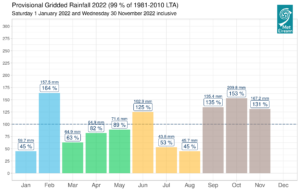
Provisional monthly gridded 2022 rainfall (%) for Ireland on a monthly basis.
Temperature: Above average everywhere for the sixth consecutive season
All mean air temperatures across the country were above their LTA for the season. Deviations from mean air temperature for the season ranged from 0.8 °C (10.8 °C mean temperature) at Markree, Co Sligo to 1.5 °C (11.7 °C mean temperature) at Phoenix Park, Co Dublin. Mean temperatures for the season ranged from 10.2 °C (1.2 °C above its LTA) at Knock Airport, Co Mayo to 13.1 °C (1.1 °C above its LTA) at Sherkin Island, Co Cork (its warmest autumn since 2007). The season’s lowest temperatures were recorded on Saturday 19th Nov with the lowest air minimum reported at Athenry, Co Galway with a temperature of -1.8 °C and the lowest grass minimum reported at Mount Dillon, Co Roscommon with -6.5 °C. The highest maximum was reported on Thursday 1st Sep at Newport, Co Mayo with a temperature of 22.7 °C. More than half of stations reported ground frost. The number of days with ground frost ranged from zero days at Malin Head, Co Donegal to 29 days at Mount Dillon, Co Roscommon. Less than half of stations reported air frost. The number of days with air frost ranged from zero days at a few stations to 7 days at Mount Dillon, Co Roscommon. Valentia Observatory, Co Kerry also had its warmest autumn since 2007. Cork Airport had its warmest autumn since 2001 and Johnstown Castle, Co Wexford had its warmest autumn since 2006. Roches Point, Co Cork had its warmest autumn on record (length 19 years).
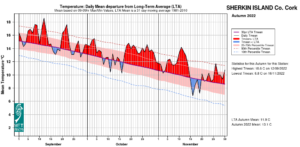
Sherkin Island, Co Cork Temperature: Daily mean departure from LTA for autumn 2022
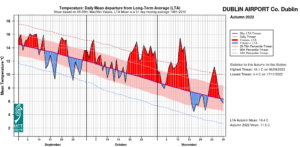
Dublin Airport Temperature: Daily mean departure from LTA for autumn 2022
Sunshine: Sunniest in the East
All available sunshine totals were above their LTA for the season. Percentage of seasonal sunshine values ranged from 103% (seasonal sunshine total of 277.8 hours) at Shannon Airport, Co Clare to 114% (the season’s highest seasonal sunshine total of 333.0 hours) at Casement Aerodrome, Co Dublin. Seasonal sunshine totals were lowest at Belmullet, Co Mayo with 252.7 hours (no LTA comparison*). The highest number of daily sunshine hours recorded this season was 12.3 hours at Malin Head, Co Donegal on Saturday 10th Sep. The number of dull days2 ranged from 17 days at Casement Aerodrome, Co Dublin to 27 days at Valentia Observatory, Co Kerry.
Wind: Strong gales reported in all three months, storm force winds reported in November
Seasonal mean wind speeds ranged from 6.2 knots (11.5 km/h) at Moore Park, Co Cork to 16.4 knots (30.4 km/h) at Mace Head, Co Galway (its strongest mean winds in autumn since 2011). There were numerous days with gales and strong gales with up to storm force winds on Wednesday 23rd Nov. The number of days with up to strong gales ranged from zero days at a few stations to 5 days at Mace Head, Co Galway. The number of days with storms force winds was 1 day at Mace Head, Co Galway. The season’s highest gust was reported at Roche’s Point, Co Cork on the 24th Nov with 65 knots (120 km/h). The season’s highest 10-minute mean wind speed was 48 knots (89 km/h) at Mace Head, Co Galway on Wednesday 23rd Nov. Along with Mace Head ten other stations had their strongest mean wind for autumn since 2011. Roches Point, Co Cork had its strongest mean wind for autumn on record (length 19 years).
The full report is available here (choose Autumn on drop down menu for month) or the PDF is available here

Autumn 2022 extreme values at synoptic stations
November 2022
Mild, sunny and windy. Wet in most places, especially the Southwest
November 2022 was a mild and windy month, dominated by Atlantic low pressure systems to the west of Ireland, with the airflow mostly between southerly and south-westerly. This setup steered many tropical maritime air masses over the country during the month, bringing mild conditions and rain on most days. Numerous active weather fronts crossed the country from the south and southwest, interspersed with showery periods. This resulted in the windward facing counties of the South and West receiving the bulk of the rainfall. The first week saw active weather fronts, or heavy thundery showers, affecting the Southwest daily. Active weather fronts also affected the rest of the country at times, especially on the 2nd and 7th, with sunshine and showers on other days. The East of the country escaped with mostly light rain. This theme continued through the rest of the month, with frontal troughs bringing widespread falls of rain, especially on the 13th, 21st, 23rd and 24th, interspersed with sunny spells and showery periods. The rain was heaviest and most persistent in the South and West, with the East mostly escaping with lighter falls. It became drier towards the end of the month as high pressure built over Scandinavia and began to push westwards.
Rainfall: Above average in most places, wettest in the Southwest
The majority of monthly rainfall totals were above their 1981-2010 Long-Term Average (LTA). Percentage of monthly rainfall values ranged from 61% (monthly rainfall total of 46.4 mm) at Phoenix Park, Co Dublin to 210% (the month’s highest monthly rainfall total of 354.8 mm) at Valentia Observatory, Co Kerry (its 2nd wettest November on record and wettest since 2009, which had 360.3 mm). Monthly rainfall totals were lowest at Dublin Airport, Co Dublin with 46.1 mm (63% of its LTA). The month’s wettest day was also recorded at Valentia Observatory, Co Kerry with 34.8 mm on Wednesday 2nd. The number of rain days ranged from 18 days at Casement Aerodrome, Co Dublin to 30 days at a few stations. The number of wet days ranged from 12 days at Phoenix Park, Co Dublin to 29 days at a few stations. The number of very wet days ranged from zero days at both Phoenix Park, Co Dublin and Casement Aerodrome, Co Dublin to 16 days at Valentia Observatory, Co Kerry. Along with Valentia, four other stations had their wettest November since 2009. These were Moore Park, Co Cork with 167.8 mm (159% of its LTA), Sherkin Island, Co Cork with 185.7 mm (154% of its LTA), Cork Airport, Co Cork with 203.4 mm (169% of its LTA) and Mace Head, Co Galway with 183.9 mm (121% of its LTA).
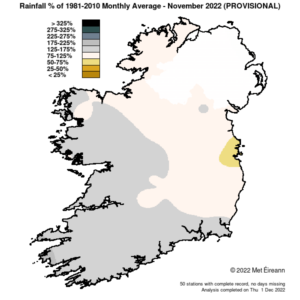
Rainfall % of 1981 – 2021 Monthly Average for November 2022 (Provisional)
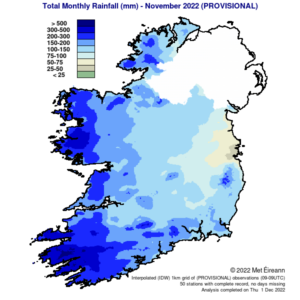
Total Monthly Rainfall (mm) for November 2022 (Provisional)
Temperature: Above average everywhere
All mean air temperatures across the country were above their LTA for the month. Deviations from mean air temperature ranged from 0.6 °C (8.0 °C mean temperature) at Markree, Co Sligo to 1.9 °C (9.1 °C mean temperature) at Phoenix Park, Co Dublin. Mean temperatures for the month ranged from 7.4 °C (1.2 °C above its LTA) at Knock Airport, Co Mayo to 10.7 °C (1.1 °C above its LTA) at Sherkin Island, Co Cork. The month’s lowest temperatures were recorded on Saturday 19th with the lowest air minimum reported at Athenry, Co Galway with a temperature of -1.8 °C and the lowest grass minimum reported at Mount Dillon, Co Roscommon with -6.5 °C. The highest maximum was reported on Sunday 13th at Finner, Co Donegal with a temperature of 17.6 °C (its highest maximum for November on record (length 25 years)). More than half of stations reported ground frost. The number of days with ground frost ranged from zero days at Malin Head, Co Donegal to 14 days at Phoenix Park, Co Dublin. Less than half of stations reported air frost. The number of days with air frost ranged from zero days at a few stations to 5 days at Mount Dillon, Co Roscommon. Seven stations had their warmest November since 2011. Fourteen stations broke their highest daily minimum temperature record for November on Friday 11th, with a new November highest daily minimum temperature record for Ireland of 14.9°C recorded at Shannon Airport, Co Clare.
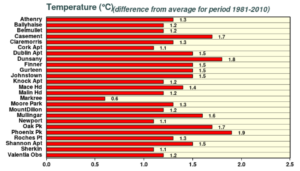
November 2022 monthly mean temperature °C difference from 1981 – 2021 average (Provisional)
Sunshine: Sunny in most places
All available sunshine totals were above their LTA. Percentage of monthly sunshine values ranged from 121% (monthly sunshine total of 71.6 hours) at Shannon Airport, Co Clare to 133% (monthly sunshine total of 87.2 hours) at Casement Aerodrome, Co Dublin. Monthly sunshine totals ranged from 42.9 hours (No LTA comparison*) at Valentia Observatory, Co Kerry to 88.7 hours (No LTA comparison*) at Gurteen, Co Tipperary. The highest number of daily sunshine hours recorded this month was 7.5 hours at Johnstown Castle, Co Wexford on Friday 18th. The number of dull days ranged from 5 days at Casement Aerodrome, Co Dublin to 12 days at Shannon Airport, Co Clare. Malin Head, Co Donegal had an unusually sunny November with 76.2 hours.
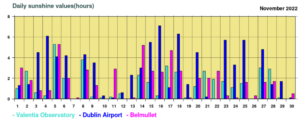
November 2022 daily sunshine values at selected stations (provisional)
Wind: Windy with storm force winds reported
Monthly mean wind speeds ranged from 6.7 knots (12.4 km/h) at Moore Park, Co Cork and Mount Dillon, Co Roscommon to 19.8 knots (36.7 km/h) at Mace Head, Co Galway. Gales were reported on 13 days with strong gales reported on the 2nd, 7th, 10th, 11th, 22nd, 23rd, 24th and 26th. Mean wind speeds were storm force on Wednesday 23rd at Mace Head, Co Galway. The number of days with gales ranged from zero days at a few stations to 11 days at Mace Head, Co Galway. The number of days with up to strong gales ranged from zero days at a few stations to 4 days at Mace Head, Co Galway. The number of days with storms force winds was 1 day at Mace Head, Co Galway. The month’s highest gust was reported at Roche’s Point, Co Cork on Thursday 24th with 65 knots (120 km/h). The month’s highest 10-minute mean wind speed was 48 knots (89 km/h) at Mace Head, Co Galway on Wednesday 23rd.
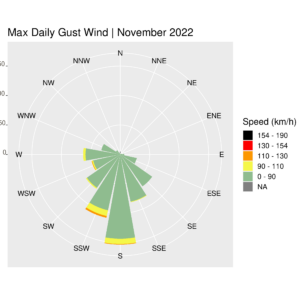
Wind rose for Ireland Max Daily Gust November 2022 (provisional)
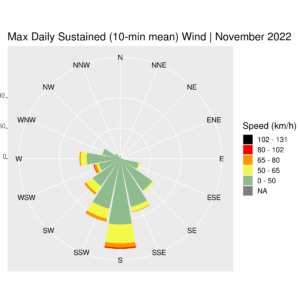
Wind rose for Ireland Max Daily Sustained (10-min mean) November 2022 (provisional)
The full report is available here

November 2022 extreme values at synoptic stations
Recent Novembers in Ireland:
- 2016: Nearly all stations reported below Long-Term Average (LTA) for rainfall while all stations reported below their LTA for temperature and sunshine values were variable.
- 2017: Rainfall was below average at most stations, mean air temperatures were mostly below average also, while sunshine totals were above average.
- 2018: Rainfall and mean temperatures were mostly above average. Above-average sunshine totals in the North and West, below average in the south and east. Storm Diana brought strong gales to the South and West.
- 2019: The majority of monthly rainfall totals were above their LTA, mean air temperatures were below everywhere. Sunshine totals were mixed, dull in the East and North.
- 2020: Rainfall was above average in most places, highest in the West and Northwest, while temperatures were above average everywhere. Sunshine totals were above average in the South and East.
- 2021: The majority of monthly rainfall totals were below their LTA while all mean air temperatures were above average everywhere. It was sunny in the South, dull in the North and Northwest. Storm Arwen brought storm force winds on the 26th.